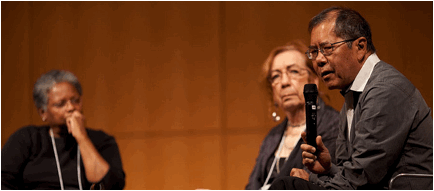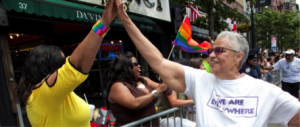Our country is growing older and more diverse. Are we prepared?

A historic shift is occurring.
In the coming decades, our older population will grow far more racially, ethnically, and culturally diverse. As the population of older Americans doubles in size from 2010 to 2050, diverse Americans will constitute an increasingly larger segment of that group. Moreover, in the next 15 years, people of color will make up 1 in 3 older Americans, and the lesbian, gay, bisexual, and transgender (LGBT) older population will double in size to at least 4 million. We must prepare for these dramatic demographic shifts.
The growing diversity of the U.S. aging population will affect our society and communities in major ways, challenging policymakers and programs to pay attention to the needs of a culturally and linguistically diverse population.
Diverse older adults face a host of challenges—from health disparities to access to affordable housing to economic insecurity, and more. Here are three of the biggest challenges facing diverse elders today:
Limited access to higher education, employment discrimination, a history of low wages without pensions or retirement benefits are just some of the factors that contribute to the economic insecurity of diverse elders. These harsh realities result in reduced lifelong earnings, lower Social Security benefits, and fewer financial options and opportunities in their later years. In 2010, 6.8% of elder whites were poor compared to 18% of elder African Americans, 18% of elder Hispanics, and 14.6% of elder Asians.[i] Likewise, one study found that same-sex elder couples face higher poverty rates than their heterosexual peers; 9.1% and 4.9% among elder lesbian and gay couples, respectively, in contrast to 4.6% among elder heterosexual couples.
Research shows that people of color across the age span face significant disparities in physical and mental health. Additionally, many people of color delay care because of potential medical costs and out of fear of discrimination or cultural incompetence from medical providers. These issues are especially true for LGBT people of color who face challenges related to multiple aspects of their identities. For older people of color, inadequate care results in higher rates of chronic disease and higher mortality rates from HIV/AIDS, diabetes, and cardiovascular disease –as compared to their white peers. As one example, African Americans and Hispanics are disproportionately affected by HIV; infection rates for African Americans are almost eight times higher than their white counterparts, and are twice as high among Hispanics.[ii] Compounding these disparities is the lack of necessary insurance coverage—or information about available benefits—required to access quality care. Cuts to Medicare and Medicaid disproportionately affect elders of color; among those aged 55 and over, 52% of African Americans, 46% of Latinos, and 43% of Asians are covered by Medicare.
Older people of color and LGBT elders report encountering aging professionals who lack the insight and sensitivities to deal with elders with different cultural backgrounds, customs, languages and identities. And limited-English elders report a dearth in resources available in their native languages.
Recognizing the incredible diversity within our communities, we also recognize our commonalities across many of the issues described above. We formed the Diverse Elders Coalition because we realize that working in partnership will help all of us prepare for the demographic shifts that are reshaping this country. And as a coalition, we know that we can leverage our organizational resources, knowledge and expertise to advocate for change that will affect all elders.
For more information on diverse elders, explore our stories, read our blog or contact us.
Learn more about our communities:
[i] Administration on Aging, U.S. Department of Health and Human Services, A Profile of Older Americans: 2011.
[ii] “Estimates of New HIV Infections in the United States, 2007-2010.” Centers for Disease Control and Prevention. Centers for Disease Control and Prevention, 27 Dec. 2013. Web. 22 Mar. 2014. http://www.cdc.gov/nchhstp/newsroom/2012/HIVIncidenceGraphics.html.





